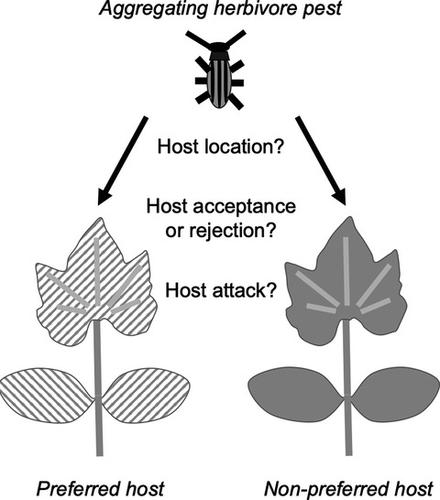当前位置:
X-MOL 学术
›
J. Appl. Ecol.
›
论文详情
Our official English website, www.x-mol.net, welcomes your feedback! (Note: you will need to create a separate account there.)
Attack and aggregation of a major squash pest: Parsing the role of plant chemistry and beetle pheromones across spatial scales
Journal of Applied Ecology ( IF 5.7 ) Pub Date : 2020-06-28 , DOI: 10.1111/1365-2664.13689 Lauren J. Brzozowski 1 , Jeffrey Gardner 2 , Michael P. Hoffmann 2 , André Kessler 3 , Anurag A. Agrawal 2, 3 , Michael Mazourek 1
中文翻译:

主要南瓜害虫的侵袭和聚集:解析植物化学和甲虫信息素在空间尺度上的作用
更新日期:2020-06-28
Journal of Applied Ecology ( IF 5.7 ) Pub Date : 2020-06-28 , DOI: 10.1111/1365-2664.13689 Lauren J. Brzozowski 1 , Jeffrey Gardner 2 , Michael P. Hoffmann 2 , André Kessler 3 , Anurag A. Agrawal 2, 3 , Michael Mazourek 1
Affiliation

|
- Successful management of insect crop pests requires an understanding of the cues and spatial scales at which they function to affect rates of attack of preferred and non‐preferred host plants. A long‐standing conceptual framework in insect–plant ecology posits that there is hierarchical structure spanning host location, acceptance and attack that could be exploited for integrated pest management.
- We investigated how plant‐ and insect‐derived chemical cues affect successive decisions of host choice in aggregating insects, and tested predictions in the Cucurbita pepo–Acalymma vittatum system. Acalymma vittatum is an aggregating specialist beetle pest that strongly prefers zucchini (C. p. pepo) to summer squash (C. p. ovifera), two independent domesticates of C. pepo. We hypothesized that subspecies‐specific plant traits, especially volatile cues, interact with the male‐produced aggregation pheromone to amplify beetle preference for C. p. pepo.
- Differential beetle attack of C. pepo subspecies in the field is not determined by plant traits that affect host finding or differential aggregation due to pheromones: across two years, beetles had strong density‐dependent attraction to both subspecies when male beetles were feeding, and no interactions between plant volatiles and the male‐produced pheromone were detected. In the absence of male pheromone emission, beetles were equally unattracted to plants with or without beetle feeding.
- In contrast, plant traits that mediate insect acceptance appear to underlie differences in preference. At a local scale, beetles did not accept and emigrated from C. p. ovifera compared to C. p. pepo. Distinct volatile emissions were observed between subspecies, but further work is needed to identify if these volatiles promote emigration.
- Synthesis and applications. By dissecting pest preference during successive host choice decisions, we isolated a trait with implications for pest management. Beetles on cucurbits can be managed by employing cultivars with differential susceptibility (e.g. trap cropping), and the mechanistic knowledge presented here informs best practices and limitations for on‐farm applications. More broadly, pest management in diversified cropping systems can be enhanced through understanding how plant preference gradients affect herbivore movement and behaviour, and plant breeders can target traits to reduce herbivory in such systems.
中文翻译:

主要南瓜害虫的侵袭和聚集:解析植物化学和甲虫信息素在空间尺度上的作用
- 要成功地管理虫害,需要了解其作用于影响首选和非首选宿主植物的侵袭率的线索和空间尺度。昆虫-植物生态学中一个长期的概念框架认为,存在跨越宿主位置,接受和攻击的层次结构,可以将其用于有害生物综合治理。
- 我们调查了植物和昆虫来源的化学线索如何影响昆虫聚集中宿主选择的连续决策,并检验了南瓜(Cucurbita pepo)-Acalymma vittatum系统中的预测。Acalymma vittatum是一种聚集的特殊甲虫害虫,它比西葫芦(C. p。ovifera)强烈青睐西葫芦(C. p。pepo),这是两个独立的C. pepo驯养动物。我们假设亚种特有的植物性状,尤其是易变的线索,与雄性产生的聚集信息素相互作用,从而放大了甲虫对C. p。的偏好。西葫芦。
- 田间对C. pepo亚种的甲虫的不同攻击并不取决于影响寄主发现或由于信息素引起的差异聚集的植物性状:在过去的两年中,甲虫在雄性甲虫觅食时对这两个亚种具有强烈的密度依赖性吸引力,并且没有检测了植物挥发物和雄性产生的信息素之间的相互作用。在没有雄激素信息素释放的情况下,甲虫对有或没有甲虫饲养的植物同样没有吸引力。
- 相反,介导昆虫接受的植物性状似乎是偏好差异的基础。在当地范围内,甲虫没有接受并从C. p。移居。ovifera相比C.第 西葫芦。在亚种之间观察到明显的挥发物排放,但是需要进一步的工作来确定这些挥发物是否促进移民。
- 综合与应用。通过在连续的寄主选择决策过程中剖析害虫的偏好,我们分离出一种对害虫管理具有影响的性状。葫芦科植物上的甲虫可以通过使用敏感性不同的栽培品种来管理(例如圈套作物),这里介绍的机械知识可为农场应用提供最佳实践和限制。更广泛地讲,通过了解植物偏好梯度如何影响食草动物的运动和行为,可以增强多种作物系统中的有害生物管理,植物育种者可以针对性状减少这类系统中的食草动物。


























 京公网安备 11010802027423号
京公网安备 11010802027423号